National Cambridge Collectors, Inc.
A non-profit 501(c)(3) organization.

Cambridge Crown Tuscan
By Phyllis D. Smith. Photos by Helen Klemko
The following article was originally published the June/July 1992 issue of Glass Collector's Digest. We have received permission from the authors to publish it on our web site.
The words Crown Tuscan immediately bring to mind the beautiful opaque glass manufactured by the Cambridge Glass Company, Cambridge, Ohio. Used by Cambridge for a period of some 20 years, this extraordinary lovely color can be found in varying shades from light pink to dark tan, and in a depth range that varies from nearly translucent to opaque.
First introduced to the public via an announcement in the September 1932 issue of the trade magazine China, Glass and Lamps, Crown Tuscan continued in production by Cambridge until the factory closed in 1954. Evidently it was not produced during their reopen period from 1956 to 1958.
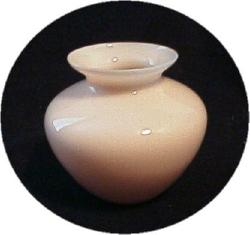 The announcement in the trade magazine read as
follows: "The Chicago showrooms of Cambridge Glass Co. are
displaying the 'Crown Tuscan' line which has been received with
much interest since its recent announcement. This opaque glass
with its rich cream-like color is offered in a wide choice of
fancy and table pieces including vases, bowls, side-dishes, ball
jugs, etc. This Cambridge line carries a hallmark on the bottom
of each piece after the manner of dinnerware. This hallmark
consists of a crown with the name 'Tuscan.'" In the February 1933
issue of China, Glass and Lamps the following
description appears: "CROWN TUSCAN - A whitish pink opaque glass
in vases, bowls and fancy pieces for table and home
decoration."
The announcement in the trade magazine read as
follows: "The Chicago showrooms of Cambridge Glass Co. are
displaying the 'Crown Tuscan' line which has been received with
much interest since its recent announcement. This opaque glass
with its rich cream-like color is offered in a wide choice of
fancy and table pieces including vases, bowls, side-dishes, ball
jugs, etc. This Cambridge line carries a hallmark on the bottom
of each piece after the manner of dinnerware. This hallmark
consists of a crown with the name 'Tuscan.'" In the February 1933
issue of China, Glass and Lamps the following
description appears: "CROWN TUSCAN - A whitish pink opaque glass
in vases, bowls and fancy pieces for table and home
decoration."
In 1930, the Cambridge Glass Company hired a brilliant glass chemist by the name of Henry T. Hellmers. He was employed by Cambridge until 193, and it is he who is credited with the development of the Crown Tuscan color. During his career, that spanned a period of more than 42 years, Mr. Hellmers worked at many of the well-known glass houses, developing glass color formulas. These factories included: Akro Agate (color for marbles as well as children's dishes); Westite (colors for bathroom fixtures); Cambridge (colors other than Crown Tuscan included mulberry, willow blue, and heartherbloom to name but a few); Heisey (Alexandrite); Aladdin Industries (Alacite); and many others. Is it any wonder that collectors today sometimes confuse glass pieces manufactured by Cambridge, Akro Agate, Aladdin, and others? After all, the same man invented similar colors for each of them.
It is conceivable that any piece of glass manufactured by the Cambridge Glass Company, after September 1932, could be found in the Crown Tuscan color. The #3500 (Gadroon), #3400, #3011 (Nude stem), #1066, #1311, #1402 (Tally-Ho), Everglade, Swan, and novelties of every description are but a few of the items and lines that may be found in this color. Every etching and decoration being used during this time period may also be found on pieces of Crown Tuscan. There is no limit, except to your own imagination, when it comes to items that may be (and have been) found in this highly collectible color.
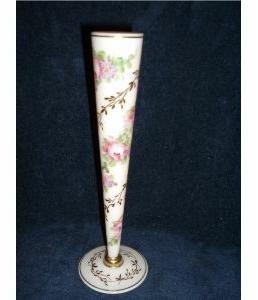 One of the
more beautiful and collectible decorations found on Crown Tuscan
pieces was not done by the Cambridge Glass Company Rather, these
decorations which included various flowers and picturesque
scenes, called "Charleton," were the product of a decorating
company headquarted in New York City. "Charleton" was the
registered trademark for this group of hand decorations done by
the Abels, Wasserberg & Co., Inc. of New York. This company
purchased glass pieces from several of the glass factories of
that day - including Fenton, Fostoria, Jeannette, Westmoreland,
Aladdin, and Cambridge - and applied their own hand decorations
before selling them under their own label and in their own
showrooms. As indicated by a July 1943 advertisement appearing
The Gift and Art Buyer, the Abels, Wasserberg & Co.,
Inc. had showrooms in Chicago and Los Angeles, as well as in New
York. Our limited research material does not allow for further
speculation on this decorating company except to say that they
were in business in 1943 and were still advertising the
"Charleton" decorated Cambridge pieces in a May 1952 issue of
Crockery & Glass Journal.
One of the
more beautiful and collectible decorations found on Crown Tuscan
pieces was not done by the Cambridge Glass Company Rather, these
decorations which included various flowers and picturesque
scenes, called "Charleton," were the product of a decorating
company headquarted in New York City. "Charleton" was the
registered trademark for this group of hand decorations done by
the Abels, Wasserberg & Co., Inc. of New York. This company
purchased glass pieces from several of the glass factories of
that day - including Fenton, Fostoria, Jeannette, Westmoreland,
Aladdin, and Cambridge - and applied their own hand decorations
before selling them under their own label and in their own
showrooms. As indicated by a July 1943 advertisement appearing
The Gift and Art Buyer, the Abels, Wasserberg & Co.,
Inc. had showrooms in Chicago and Los Angeles, as well as in New
York. Our limited research material does not allow for further
speculation on this decorating company except to say that they
were in business in 1943 and were still advertising the
"Charleton" decorated Cambridge pieces in a May 1952 issue of
Crockery & Glass Journal.
Webmaster's note: Since this article was written, much more information has been found regarding Abels, Wasserberg & Co. You can find out more by reading the article on The Charleton Line.
Beginning in 1935, the Cambridge Glass Company introduced a
"new" color name - Coral. It is widely believed (and debated by
some) that this was not actually a new color formula, but rather
a name more appropriate than Crown Tuscan to use with their new
Sea Shell line. Research information indicates that is no
specific evidence that this was a distinct new color formula. The
fact that the Coral name was used until 1949 for the Sea Shell
line ONLY, and then dropped altogether by the Cambridge company
could be construed to prove this point. After 1949 Cambridge had
stopped using the Coral name and they were, once again, using the
Crown Tuscan name on all lines, include Sea Shell.
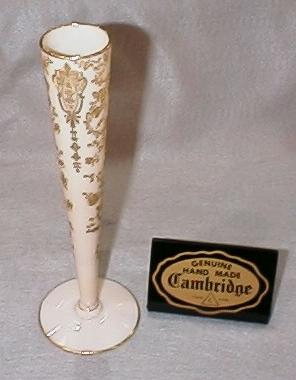 The Crown
Tuscan "trademark, hallmark, or acid stamp mark" was used from
1932 to 1934, on items in the #3400; #3500 and #3011 lines.
However, it was not used on ALL Crown Tuscan items found in these
lines. It is not known why it appeared on some items, and not on
others. It did not appear on the Sea Shell line (introduced in
1935) or items with Rosepoint decoration (Rosepoint was
introduced in 1934); but it has been seen on items decorated with
Diane, Chintz, and Portia. These etchings were all introduced
prior to 1934, hence the dating of the use of the Crown Tuscan
trademark.
The Crown
Tuscan "trademark, hallmark, or acid stamp mark" was used from
1932 to 1934, on items in the #3400; #3500 and #3011 lines.
However, it was not used on ALL Crown Tuscan items found in these
lines. It is not known why it appeared on some items, and not on
others. It did not appear on the Sea Shell line (introduced in
1935) or items with Rosepoint decoration (Rosepoint was
introduced in 1934); but it has been seen on items decorated with
Diane, Chintz, and Portia. These etchings were all introduced
prior to 1934, hence the dating of the use of the Crown Tuscan
trademark.
For the beginning collector of Cambridge Crown Tuscan, please be advised, once again, that several other glass companies did make a color similar to Crown Tuscan. To the inexperience eye, they can seem to be the same. The most important thing to do when starting to collect Cambridge, or glass from any company, is to study. Learn to recognize shapes and pattern lines. Other companies making glass similar in color to Cambridge's Crown Tuscan include: Fenton, Fostoria, Jeannette, Westmoreland and Aladdin.
The Cambridge Glass Company pressed their first piece of glass in May 1902 and closed their doors for the final time in 1958. During the years between they produced a variety of glassware second to none! Their early pressed ware bore the trademark "Near Cut" pressed into the glass. Later, in the 1920s, the letter "C" enclosed within a triangle became their trademark and was pressed into many pieces of this lovely glass. But not all pieces bore this trademark, hence the importance of "Study" to any collector of Cambridge glass. In 1960 the assets of the company were sold to the Imperial Glass Company. In early 1985 the Imperial Glass Company was liquidated and the National Cambridge Collectors, Inc. was able to purchase most of the old Cambridge Glass Company molds, etching plates, tools, etc. These items are now hosed in a large storage building located behind the national Cambridge Collectors' Museum of Cambridge Glass, in Cambridge, Ohio. If you have an opportunity, please visit this outstanding facility.
Photos below were also printed in the issue. Scanner shows yellow lines for some strange reason!
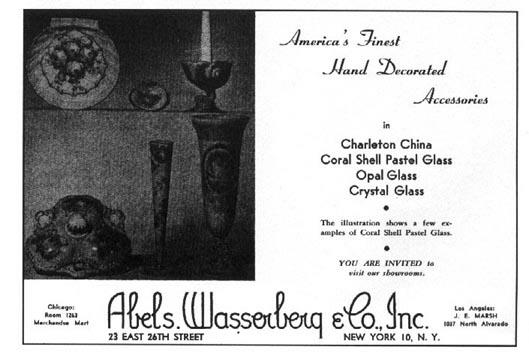 Charleton Advertisement |
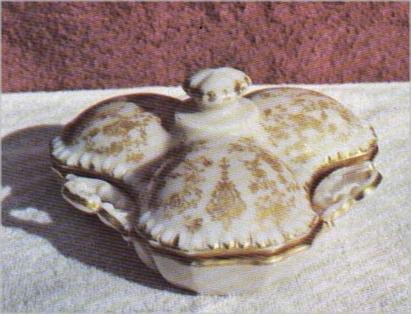 Rose Point covered 3-part Candy |
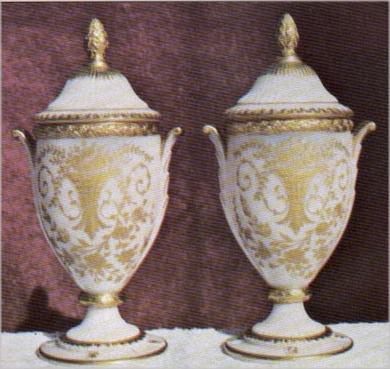 Pair of gold encrusted Portia Urns |
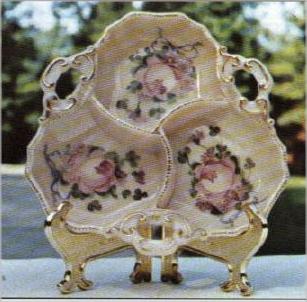 Charleton decorated 3-part Relish |
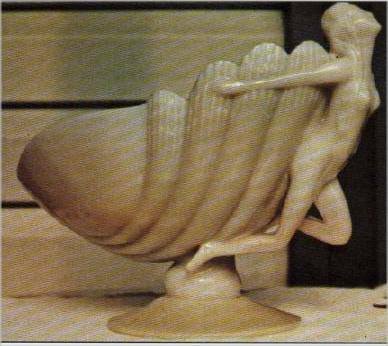 Crown Tuscan Flying Lady bowl |
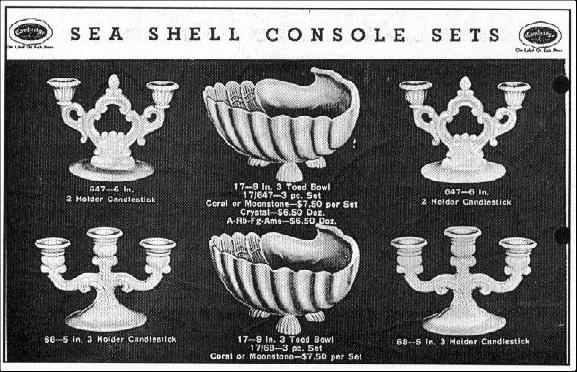 Page from 1940 Catalog |